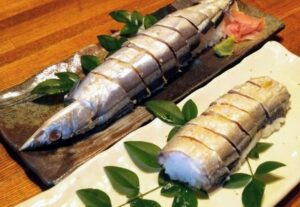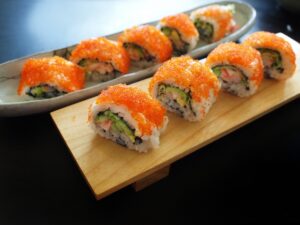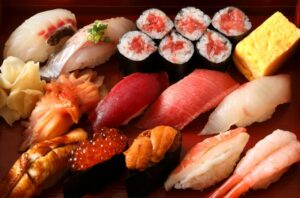the history of sushi and its evolution

Sushi is now one of the most popular Japanese foods loved around the world, but it has a very long and deep history. What forms did sushi take before the appearance of nigirizushi and kaitenzushi as we know it today? And how did it evolve into what it is today? In this article, we will trace the history of sushi from its origins to the present day, and explore the evolution of sushi culture.
1 Origin of Sushi: Beginning as a Fermented Food

The origin of sushi is believed to date back to China around the 5th century BC. Its origins can be traced to a fermented food called “sushi. This fermented food consisted of fish and rice preserved with salt and used as a preservation method for eating fish. Sushi in ancient times was quite different from what we now call sushi; rather, it was used as a type of preserved food.
Sushi as a fermented food was introduced to Japan around the 9th century. In early Japan, the most common method was to ferment fish and rice together, and the rice was not eaten in the process, but was used as a preservation method for eating the fish. Sushi of this period was called “nare-zushi” and mainly employed the method of fermenting fish that had been preserved for a long period of time.
2 Edo Period: Birth of Nigiri-zushi

Sushi evolved into its current form in Japan during the Edo period (1603-1867). In the early Edo period (1603-1867), “vinegared sushi” or “Edomae-zushi,” in which fish is cooked with vinegar, began to become popular. The townspeople of Edo (present-day Tokyo) began to demand food that was quick and easy to prepare, and it is believed that nigirizushi was born in response to this need.
There are many theories about the origins of nigirizushi, but one theory says that an Edo period sushi chef named “Sushi chef Ishikawa” established the style of nigirizushi, in which fish is served on vinegared rice and nigirizushi is served. This style quickly became popular, and nigirizushi spread mainly in Edo (present-day Tokyo).
Nigiri-zushi in the Edo period was quite simple compared to what we have today. The vinegared rice was somewhat acidic and the ingredients were limited, but it still enjoyed great popularity due to its simplicity and delicious taste. Sushi restaurants in Edo were able to operate in the city and were loved by the common people as a casual place to stop by during lunch time or after work.
3 After the Meiji Era: Spread and Change of Sushi

In the Meiji Era, sushi gradually spread across the country, with each region adding its own unique characteristics. Sushi restaurants appeared not only in urban areas but also in rural areas, and the skills of sushi chefs became more sophisticated. While maintaining the style of nigirizushi of the Edo period, various innovations were made, and the variety of ingredients and cooking methods became more diverse.
The style of sushi that emerged during this period was the artisanal style of nigirizushi, in which sushi is made and served with the skill of a chef. This style of sushi can still be found in many sushi restaurants today. Also during this period, the “ingredients” for sushi became more diversified, and nori maki (rolled sushi) and chirashizushi became commonly eaten.
In the Showa period (1926-1989), sushi evolved further and became one of the national foods. Especially during the period of rapid economic growth after World War II, sushi was commercialized and sushi chain restaurants appeared. The price of sushi became more affordable, and it became a dish that could be easily enjoyed by the general public. Around this time, more convenient ways to enjoy sushi appeared, such as conveyor-belt sushi and take-out sushi, making sushi more and more popular among the public.
4 Modern Sushi: A Fusion of Innovation and Tradition

In the modern era, sushi has become a symbol of Japanese food loved around the world and incorporated into the culinary culture of many countries. Even within Japan, there are many different styles of sushi. For example, “counter sushi,” where a sushi chef prepares the ingredients in front of you, remains popular, but conveyor-belt sushi and take-out sushi are also becoming popular. All of these have developed in response to consumer needs.
Overseas, sushi is one of the most famous Japanese foods, and many countries have experienced a “sushi boom. In addition to traditional nigirizushi and makizushi, sushi restaurants overseas have introduced unique sushi using ingredients from the country of origin. For example, in the United States, California rolls are widely accepted and creative sushi using avocado and crab cakes are popular.
In Japan, “sushi craftsmanship” has become more important in recent years, and many people love sushi restaurants where the handiwork of skilled sushi chefs shines through. The value of sushi as a culinary culture is not just as a dish, but its technical and artistic aspects are increasingly valued.
5 The Future of Sushi

The future of sushi is expected to continue to evolve. While technological advances have led to innovative attempts to automate sushi, for example, and to use AI to create sushi, the fusion of traditional artisanal techniques with modern elements will continue to gain popularity around the world.
New forms of sushi are also increasing, such as take-out, delivery, and even fusion sushi. These changes will provide an easier way to enjoy sushi, and will make sushi more appealing to an ever-increasing number of people.
Conclusion

The history of sushi began as a fermented food, evolved into its current form during the Edo period (1603-1867), and became a dish loved around the world during the Meiji period (1868-1912) and postwar period (1945-1945). Sushi has evolved with each era, and today it is enjoyed in a variety of styles as a cuisine that combines tradition and innovation. Sushi will continue to open up a new future with the addition of technology and creativity.
